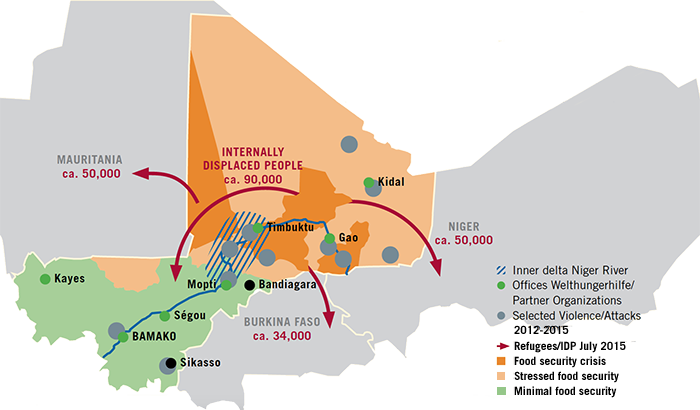Mali:
Hunger, Harassment and Hope
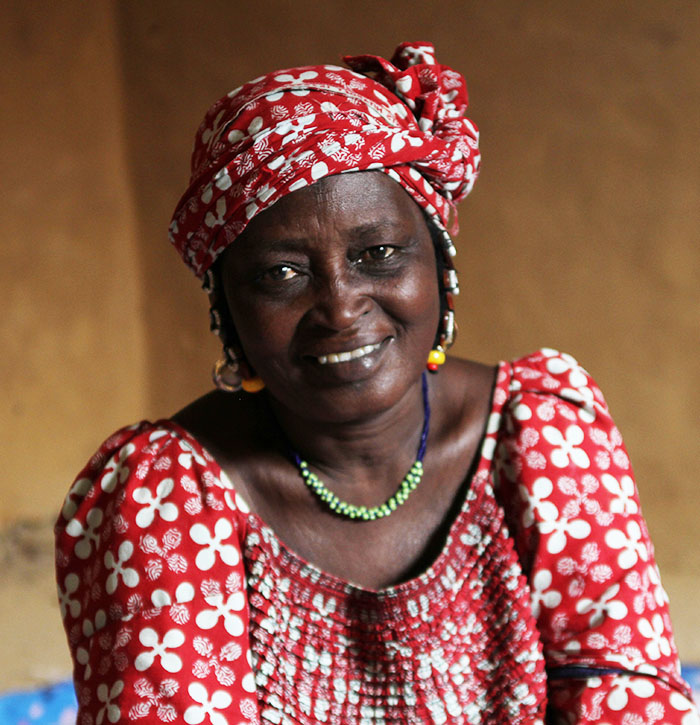 Hadi Mahamane from Toya, a small village southwest of Timbuktu
Hadi Mahamane from Toya, a small village southwest of Timbuktu
Surrounded by sand dunes, Toya, a small village southwest of Timbuktu, is located near the Niger River in the Sahara Desert of northern Mali.
People depend on the river for their survival. Its tributaries irrigate their fields. They fish in the river. Their cattle graze along its banks. In 2012, everyday life here was suddenly disrupted when violent insurgents invaded the village and attacked those who could not escape.
Sixty-five-year-old Hadi Mahamane vividly remembers:
I also tried to flee. But I soon ran out of money and had to return after two months only. I went back home and took care of my children’s children. We were ten people in the house, living from what was left behind and through our neighbors’ solidarity. Those who had a sheep or a bag of rice shared it. Gardening was not possible. Even if women would have been allowed to leave the house, the spirit wasn’t there. We lived, were physically present, but the fear paralyzed us. I never ate to my satisfaction, in order to give to the children. But it was still not enough. They were weak and I took them to the local health center. There, they told me, that the children aren’t sick, they’re hungry.
Her story says much about Mali’s recent crisis, which saw women and children isolated in their houses while men went in search of money and food. Others left in shame, as they had no way to oppose the rebels’ arms and so were forced to watch the insurgents harassing their wives and children.
Security Deteriorating in the North
4.1%
of the Malian population is undernourished.
12.7%
of children under five are wasted.
38.3%
of the children under five are stunted.
12.3%
of children die before the age of five.
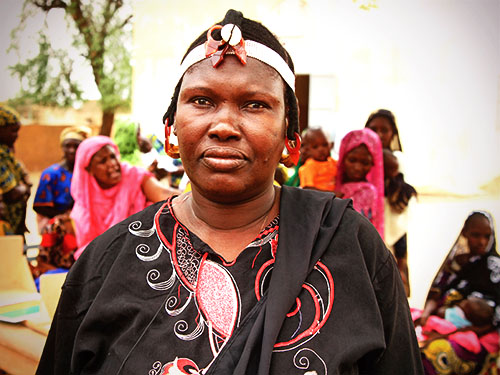 Fatimata Dicko, a community leader at the health center in Kabara, south of Timbuktu
Fatimata Dicko, a community leader at the health center in Kabara, south of Timbuktu
Mali’s northern territories fell under control of Tuareg separatists when soldiers launched a military coup against the government in March 2012. Low-ranking officers had been unsatisfied with the government’s inaction, and felt underequipped for the fight against the northern Tuareg rebellion since January 2012.
Tuaregs traditionally live a nomadic pastoral lifestyle across the Sahara and the northern Sahel Region. In April 2012, Tuareg separatists allied with criminal networks and Islamist extremists who partly originated from neighboring countries. They used the existing power gap to attack major towns in the north and advance further south.
At the beginning of the violent insurgency in the north, around 4.6 million Malians were already suffering from food insecurity caused by a lack of rains in 2011 (UN OCHA 2012). This drought in conjunction with the return of unemployed and highly armed Tuareg soldiers from Libya finally triggered the crisis in the north. Tuaregs have always fought for more autonomy in the north and have claimed as independent Azawad the traditional Tuareg territory across the Sahara and Sahel Region. This claim dates back to colonial times.
However, within a few days of the insurgency’s start, the Tuareg-dominated National Movement for the Liberation of Azawad (MNLA) invaded Gao, Kidal and Timbuktu with the support of Islamist extremists. Extremists took over and imposed their own Islamic rules and regulations on local population. Many human rights abuses were reported. The violations that took place reduced social cohesion and undermined the respect for the rule of law.
When the rebels of the MNLA invaded Toya in April 2012, they took everything they could find: Motor pumps, fuel, motorbikes, tools, etc. People were seriously afraid. Some fled; others were locked in their houses. No one actually slept.
...describes the village chief Yacouba Mahamane Touré...
The majority of the villagers are farmers who rely on agriculture. Everybody farms, even the Peul [cattle herders], and the Bozo [fishers]. But even if your things hadn’t been robbed, no one cultivated. Everybody was afraid to go to their fields nearby the village. Those staying further away, a bit isolated, took refuge in our village. Cattle was popular, rebels often snatched the livestock for their own consumption.
During the nine-month occupation of the north, stocks were carefully consumed and not sold. Petrol and water pumps for irrigating paddy fields and land were removed or sold in favor of cash. Agricultural fields were abandoned, chemical fertilizer restricted and infrastructure such as dykes intended to prevent the Niger from flooding were left unserved.
Livestock was stolen or died from weakness and disease as a consequence of limited movement, restricted pasture and an absence of veterinary services. Fishermen lost their livelihoods, as did those who worked alongside them. Administrative officials fled, including policemen and teachers. Cash flow halted. Shops and banks were closed. Development projects were suspended.
Women were particularly badly affected. Fatimata Dicko, a community leader at the health center in Kabara, a village 7 km south of Timbuktu town, explains:
With the rebel’s rigid policy and dressing codes, we were seriously afraid and hardly went out. We were forced to stay in the house. That means we neither had sufficient water nor food in the house. With the little we had, we managed and survived. Most of us reduced the number of meals from three to one per day. Vegetables were not available.
Children became so weak that they often succumbed to diarrhea or fever. Around a quarter of Timbuktu’s 45,000 people fled in 2012 (UN OCHA 2013).
In January 2013, the Malian army with the support of French troops regained control from the extremists over the northern territories. People celebrated their “liberation”. An African-led International Support Mission (AFISMA) was quickly established and later transformed into the United Nations peacekeeping mission Multidimensional Integrated Stabilization Mission in Mali (MINUSMA), encompassing about 12,000 personnel.
To restore constitutional democracy, presidential elections were organized under enormous international pressure and held in July 2013. First peace negotiations were conducted in 2013 in Burkina Faso and a ceasefire was reached in summer 2014. Both broke down repeatedly.
In June 2015, after months of intense discussions in Algier, Tuareg separatists and the Malian Government signed the present peace accord. This brought hope to the people but will take time to reach all parts of the vast north. Being trapped in an asymmetric conflict with different factions, the MINUSMA, working to support the accord’s implementation, has become a target of violent attacks themselves. With nearly sixty deaths since 2013, it is currently the UN’s most dangerous peacekeeping mission (UN MINUSMA 2015).
Half of Mali’s Population is Younger than Fifteen
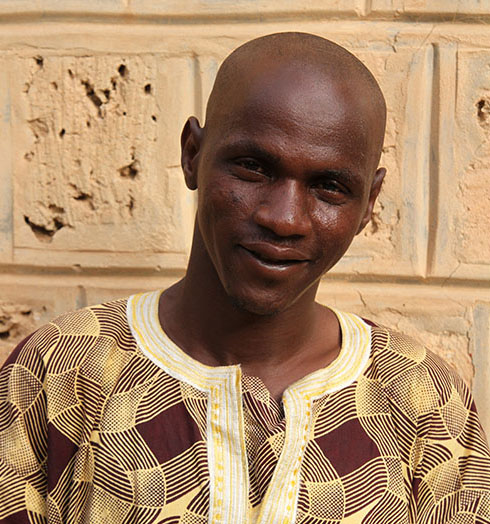 Sory Ibrahim, from Diré, a small town on the Niger River’s left bank
Sory Ibrahim, from Diré, a small town on the Niger River’s left bank
Since gaining independence from France in 1960, Mali’s population has experienced tremendous hardship resulting from chronic food insecurity and political crisis. Regional disparities and weak governance, especially in the north, have led to recurrent cycles of violence. Natural hazards, like droughts, flash floods or locust disasters, tend to occur in shorter sequences. They weaken progress made over time, and make people more vulnerable to crises, aggravating food and nutrition insecurity.
Mali still ranks as one of the poorest countries in the world and its hunger situation is considered “serious” in the 2015 GHI. The country is trapped in a vicious circle of persistent hunger and endemic poverty.
Mali’s population growth is one of the highest worldwide, with nearly half of all Malians younger than fifteen years of age. Struggling to receive adequate education and generate income or to support their families, almost half of the population is unemployed, leaving them with scarce future prospects. Economic development cannot keep pace with the population growth. Half of the population is living in poverty, on less than US$ 1.25 a day (Breisinger et al. 2015, von Grebmer, K. 2015, UNDP 2014, Wee et al. 2014).
During the occupation, everybody had to support the family. I used to be a tailor before but lost my work. So, I went to support someone producing local bricks. We had to earn something. The little we received, we used to buy food for our family.
...reports 32-year old Sory Ibrahim from Diré, a small town on the Niger River’s left bank, 120 km south of Timbuktu. He travelled to Timbuktu by boat, which is a one day’s journey. In July 2015, roads are still too dangerous and people prefer the slower but safer journey on the Niger.
Young people are particularly exposed to Mali’s crisis, facing enormous social and economic strain. Eager to take up their responsibilities in society, they lack even simple administrative documents like birth certificates needed to apply for official identity cards. Unregistered and unemployed, the young continue to be excluded from active citizenship and economic development. They remain especially prone to plans promising fast and good money. Trapped by the economic pressure and increased lack of security, many have felt forced to collaborate with violent insurgents.
Increasingly Scarce Resources Fuelling Conflict
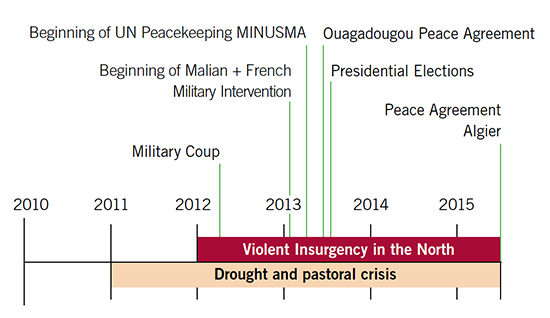
The Saharan desert covers two-thirds of Mali’s territory, and around 10 percent of the total national population of 16 million. The geographical conditions alone are challenging: Providing basic services like roads, health facilities and education, and connecting such a vast area to the country’s south, is difficult and expensive.
When the road from Douentza to Timbuktu is blocked, Timbuktu is like a prison. Nothing comes in and nothing goes out. But one has to understand that Timbuktu’s people are nomads and traders. As history shows, we have always moved freely. Farmers from the surrounding villages, even the whole region, come to Timbuktu to sell their agricultural products.
...recalls Timbuktu’s Mayor Hallé Ousmane Cissé. Not willing to leave the population of his town, the mayor had stayed throughout the crisis.
People were afraid to leave their houses. They were humiliated and demoralized.
...adds Cissé. At that time, he admits that he felt disconnected from the interim government in Mali’s capital Bamako.
This feeling of being left behind is characteristic of the relationship between the north and south, and has often led to unrest. Even though the decentralization process led to important improvements, governments have not succeeded yet in overcoming all structural and geographical obstacles. In the absence of greater autonomy for northern territories, the traditionally nomadic Tuareg in particular have remained dissatisfied, reflecting the rebellion of various separatist Tuareg groups since independence (Etang-Ndip, et al. 2015, Institute for Economics and Peace 2015, Wee et al. 2014).
Despite all demographic, socio-economic and geographical difficulties, Mali has the greatest agricultural potential of the wider Sahel Region. Around eighty percent of the population is engaged in agriculture. Most of them are smallholder farmers relying on rain-fed agriculture, keeping cattle or sheep or making a living from fishing (Wee et al. 2014). Since only three percent of the rural land is either irrigated or located along the Niger River, Mali´s agricultural output relies mainly on rainfall. While people in the dryer northern part of the country keep livestock and move around to find fertile land, people in the south live mainly from crop production.
With the main rainy season occurring between June and September, the rainfalls usually provide enough water to live by throughout the rest of the year (WFP 2015, USAID 2014). But with a changing climate, the rainfall seasons change, temperatures rise, bushland and fields turn into deserts, and people struggle to harvest their crops and feed animals. Conflicts over scarce resources are growing. With disputes over land and water, the risk of violent clashes between farmers and herders is also increasing. Rising food prices following a weak harvest or livestock deaths increase the difficulties people face feeding themselves and their families. Lack of income and unemployment reduce the purchasing power, and hunger is on the rise.
The Armed Conflict Spills Further South
A flexible approach in times of armed conflict
In 2013, Welthungerhilfe and its Malian partners were among the first to return to the north, providing emergency food assistance. At the same time, communities and displaced returnees received agricultural equipment to revive their livelihoods. To rehabilitate their agricultural infrastructure and generate initial income, people participated in cash for work programs. Community health centers were supported to prevent and treat cases of acute malnutrition and provide nutrition education for mothers. Aside from the food and nutrition security aspect, Welthungerhilfe and its partners also aim for projects focusing on conflict prevention and providing future perspectives for the youth.
As an example, young adults were offered professional training and skills development, brought together for theatre and musical projects and trained in conflict resolution skills. Until now, security in the north is shattered, and access remains difficult. To minimize risks of violent attacks and loss of goods, transport is being organized in convoys or on the Niger, and distributions are announced on a short notice. Armed conflict requires more flexibility of the international community, combining emergency aid with long-term perspectives. The Malian government and civil society have to be supported in their efforts to restore a long-lasting peace in the country.
Since the 1990s, Mali’s northern territories had seen an influx of criminal and extremist networks, undermining the relationship between government and society. Illicit financial flows, initially through cigarettes and arms trafficking and later through drug and human trafficking, led to the establishment of multiple governance structures at local levels. These illicit businesses also threatened the fragile peace, and laid the foundation for 2012’s violent insurgency.
Historically, unrest was an issue associated with the north. However, in 2015, the crisis took a new dimension, when Islamist extremists attacked towns like Sikasso, Mali’s second largest city and economic hub, less than 400 km south of Bamako.
Even before the crisis, many people in southern areas had suffered from structural poverty and food insecurity:
But the whole situation became aggravated. The food security situation worsened.
...explains André Kanambaye, coordinator of Welthungerhilfe’s local partner organization Molibemo, based in Bandiagara.
And the conflict seriously increased mistrust amongst the people. People only trust those they have known a long time. Any stranger is suspiciously regarded or easily reported to the police.
Consequences of the Armed Conflict
In mid-2013, more than
520,000
people left their place of origin in the north.
Around
170,000
fled to neighboring countries.
More than
350,000
were internally displaced, looking for refuge with relatives within Mali.
Following 2012’s political crisis and violence, people lost their agricultural production, and livestock and became more vulnerable to the annual lean season in the middle of the year. Due to displacement and a lack of investment, they missed the cultivation period in mid-2013, which aggravated the already stressed food security situation.
While conflicts in Gao and Kidal were more violent than in Timbuktu, more than 520,000 people left their place of origin in the north – 32 percent fled to neighboring Burkina Faso, Mauretania or Niger, and 68 percent to friends and family members in Mopti, Ségou or Bamako (UN OCHA 2013).
Mali, in contrast to other countries, has not seen the establishment of large displacement camps inside the country, even in the midst of the crisis. Still, people lost their personal belongings and were traumatized, having never before experienced such humiliation. Staying with families or friends also affected their ability to feed their own children. The most vulnerable who did not have any means to move stayed in their villages. The three northern regions experienced a tremendous loss in staple food.
More than 90 percent of those who were internally displaced and 75 percent of those who fled to other countries lost their animals. At the end of 2013, between 70 and 90 percent of the population in the north needed assistance from international organizations in the form of food rations (Etang-Ndip et al. 2015, WFP 2015, Coulibaly 2014, Kimenyi et al. 2014, Wee et al. 2014).
Indirect Effects Across Regional Borders
The lack of security had a negative impact on food security in other regions, too. Trading in vegetables and fruits between the south and the north was disrupted, as Mamoudou Nantoumé from Toignon, Bandiagara, explains:
In Toignon, we used to sell our vegetables to Gao, mainly tomatoes, aubergines, cucumbers and onions. We sold the products to the traders in Bandiagara, who then organized the transport and commerce with the north. In the past, they agreed to any price that we proposed. But with the crisis, they did not have the means. We used to sell the onion for 500 FCFA [80 US cents] a kilo. Today, it has reduced to 300 [50 US cents], maximum 360 FCFA [60 US cents]. There are no traders anymore. Everybody was afraid of attacks and traders stayed back. Even today, things have not changed. People are afraid. They stopped travelling.
Supra-regional livestock markets were also distorted. Between 2011 and 2013, the price of cattle more than tripled, the price of sheep quintupled and the price of goats more than doubled (Kimenyi et al. 2014).
Tourism, another important economic sector in Mali, has totally collapsed due to the northern crisis. Many foreigners around the globe used to be attracted by the beautiful Dogon Plateau and impressive Dogon culture of the Bandiagara area, a UNESCO World Heritage site. Molibemo coordinator André Kanambaye explains:
Tourists visiting Bandiagara and the Dogon Plateau disappeared. Guesthouses and restaurants are closed, tour guides, drivers and other service providers jobless. Many became unemployed, lost money, and the means to buy food stuff on the market. They were forced to go back to the field or left the area to search for new jobs in urban areas.
A Fragile Peace
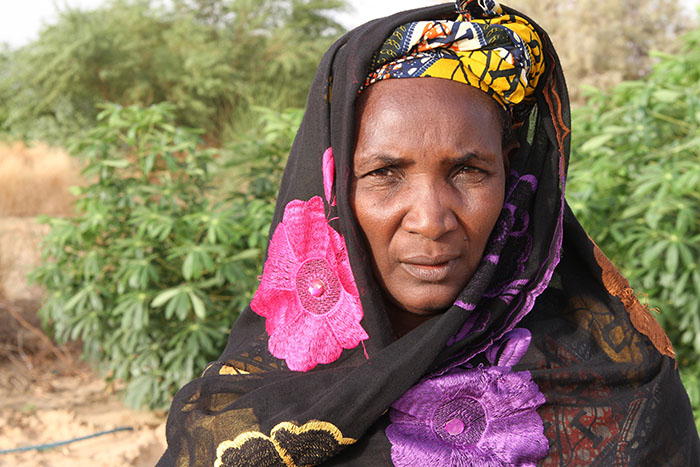 Zarin Yattara - President of a women´s group working in the Peace Garden
Zarin Yattara - President of a women´s group working in the Peace Garden
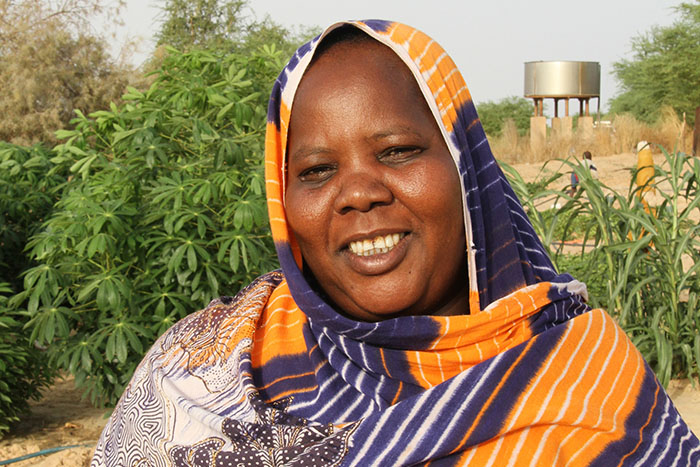 Tita Maïga - one of the women working in the Peace Garden in Timbuktu
Tita Maïga - one of the women working in the Peace Garden in Timbuktu
In 2014, the security and the food situation began to improve. People started returning to their places of origin, cultivating their land. Many humanitarian organizations picked up the work they had to leave due to the crisis. But at the beginning of 2015, ahead of peace talks in Algier, the situation worsened again. Violence reemerged, with further attacks on civilians, police and UN peacekeeping personnel. Out of fear, many are leaving their homes again, with up to 100,000 being internally displaced, in addition to the 137,000 refugees who fled to neighboring countries (UN OCHA 2015).
In 2014, the security and the food situation began to improve. People started returning to their places of origin, cultivating their land. Many humanitarian organizations picked up the work they had to leave due to the crisis. But at the beginning of 2015, ahead of peace talks in Algier, the situation worsened again. Violence reemerged, with further attacks on civilians, police and UN peacekeeping personnel. Out of fear, many are leaving their homes again, with up to 100,000 being internally displaced, in addition to the 137,000 refugees who fled to neighboring countries (UN OCHA 2015).
Leaving behind their land and livestocks disrupts their daily lives and erodes the little progress they made since the first outbreak of the crisis in 2012. The rains began late, as has the planting season, and there is a lack of pasture for the livestock. The recurring shocks resulting from droughts and violence are eroding the little means people had to survive before the armed conflict.
Building Bridges and Contributing to a Rich Food Basket
Despite the crisis, people are fighting to regain control over their lives. At the time of this writing, the situation in the town of Timbuktu has calmed, with motorbikes and cars back in town, electricity stable, banks functioning, shops and markets opened again, and even the old city hall renovated and fully functioning.
With the support of the German Foreign Affairs Office, the Peace Garden established in 1996 on the outskirts of Timbuktu was rehabilitated by Welthungerhilfe and its partner organization Association Malienne pour la Survie au Sahel (AMSS) in 2013. The Garden is a positive symbol: Women of different origin work together to overcome distrust, growing vegetables, increasing the diversity of foods they eat at home and selling products at the market which generates income for the families.
Without noticing the entrance, one could easily imagine being in the bush. When we started rehabilitating the garden before the rainy season in mid-2013, there was only sand, old and dead trees, but no garden.
...remembers Zarin Yattara, president of the Women Group Alhamdouhlaye. Today, Zarin is one of the 460 women cultivating the Peace Garden throughout the year. To rehabilitate the garden, cash for work was organized, women groups revived, cash transfers and inputs provided.
Today, we consume vegetables in our families again. Another part is given to neighbors and sold at the market in Timbuktu. With this, our children are healthy again. Even the men demand vegetables today. In the past, they denied anything apart from meat and rice. We made them taste it and they liked it. With the money we earn, we can send our children to school or buy medication.
The Garden serves the markets in Timbuktu with long beans, salad, beetroot, carrots, tomatoes and potatoes. Timbuktu’s mayor Cissé:
All over town, you can now find vegetables from the Peace Garden. Its rehabilitation increased vegetable supply in the whole district.
Nowadays, the Peace Garden in Timbuktu is famous beyond regional borders. Four hectares are cultivated and forty-two women associations are involved. But the garden is not only about vegetable production. As forty-year-old Tita Maïga vividly describes:
The idea of the Peace Garden is to bring people together. Women from all ethnic groups jointly cultivate, no matter if locals, displaced or returnees. We get along very well and regained our dignity. Women particularly suffered from the harassment and the inability to nourish our families.
With their successes, the women hope that the spirit of the peace garden may spread throughout the country.
Conclusion
Mali is a worrying example of a country’s destabilization by recurrent crises. Longstanding conflicts between farmers and cattle holders are intensified by a number of natural disasters. Livelihoods in the north are in danger, aggravated by a lack of food, assets, cattle or basic services. People who are used to living with scarce resources might be able to cope with one shock. But living through deficient years, in addition to insecurity imposed by armed conflict leaves them more vulnerable to any further crisis. People who are displaced and deprived lose the chance to grow enough food for the following year.
Armed conflict further destabilized already weak governance structures. Extremists and criminals used the power vacuum to take over in the north. It is generally an explosive mixture: with millions of young people across west and northern Africa left without future perspectives, extremists or bandits easily find recruits.
Signing the Peace Agreement by all parties was an important step forward. However, it needs to be backed up: Political and institutional reforms have to be implemented. In addition to the decentralization process, access to basic infrastructure for the people in the north must be further improved. To measure and address food and nutrition insecurity, access to the northern regions is critical. Restoring security and the rule of law should be another priority to prevent a vicious circle of hunger and armed conflict in Mali. A national reconciliation process is hardly possible without ensuring justice and human rights.
Ending dependency on emergency aid is equally important. People need to be enabled to feed themselves and to start restoring their livelihoods supported by seeds or cattle, for example. Improvement of farming and irrigation is required. Long-term and context-specific solutions should aim for a better infrastructure and a socio-economic development offering a perspective for the unemployed youth. Combining these development efforts with peace building and conflict resolution is a crucial step toward moving forward, but much more needs to be done to enable the people in Mali to live in peace and dignity.
Footnotes
About this Case Study
As we mark the tenth anniversary of the Global Hunger Index, it is time to focus on the threads which bind together the two human tragedies of hunger and armed conflict. When people are affected by violent conflict which separates them from their homes and land, disrupts planting schedules or results in the destruction of crops, their food and nutrition security inevitably suffers. Though much progress has been made in the fight against hunger, the international community continues to struggle to resolve conflicts quickly enough so that hunger and the need for humanitarian response are minimized.
Welthungerhilfe works in some of the most challenging and remote places on the planet. We witness the combined reality of hunger and armed conflict. Welthungerhilfe has worked across Mali since 1968. This country presents many of the challenges of working in a so-called ‘fragile state’: weak governance, protracted crises, cyclical environmental hazards, lack of security, an under-developed infrastructure.
Mali is also a place of beauty with people of great passion and resilience living their lives in the face of tremendous hardship. This case study gives an account of the challenges faced and the struggle to overcome them on a daily basis.
